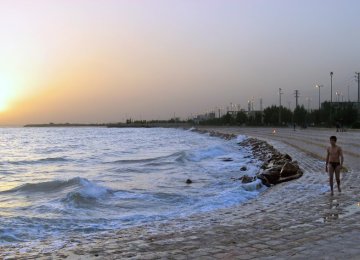The southern Hormozgan Province, with 14 islands and numerous tourist attractions, was labeled the capital of Iran’s maritime tourism last year.
Each of the islands has unique characteristics which set it apart from the next; characteristics that serve as tourist attractions. Some like Kish, Qeshm, Hormoz, Hengam, Larak, and Abu Musa are residential while others such as Lavan are residential and also have oil fields.
Islands like Farur and Bani Farur are of environmental and biological importance and home to rare species of turtles and birds.
The colorful soil of Hormoz Island, Portuguese Forts in Qeshm and Chabahar, mangrove Forests in Qeshm, and the underground city of Kish are just a few attractions one can visit when traveling to the beautiful coasts and azure waters of the Persian Gulf.
Another point of attraction in Iran’s southern water body is the spectacular diversity of flora and fauna.
Rare types of reed and algae, shale, and marine animals such as dolphins draw thousands of travelers to the islands of Kish and Bandar Lengeh.
Presence of 32 wharves and ports, including Shahid Rajaee, Shahid Bahonar, Bandar Chak, Tiyab, Khamir, Pol, and Kuhestak Ports, add to the importance of the Persian Gulf.
Rise in Maritime Tourism
In a 20-day period starting from March 16, 2014 – coinciding with the Iranian New Year holidays – 4.7 million trips were made to Hormozgan; 27,000 of which were via marine transportation.
The figure saw a 28% increase during the same period in the current Iranian calendar (started March 21).
An average of 25,000 vehicles per day was transported between the province’s ports by cargo ships. Overall, 478,920 vehicles were transported.
Long Shores, Low Profits
Compared to the northern coasts of the country, maritime tourism in Iran’s southern region is much more developed. Modern transportation system and vehicles such as passenger vessels and landing crafts encourage domestic and foreign visitors to choose the Persian Gulf as their vacation destination and opt for a sea cruise.
As Babak Arsia, secretary of the Persian Gulf National Conference put it: “The clean long shore of the Persian Gulf provides a great opportunity for investment and development of the tourism industry.”
With effective management to properly plan and build infrastructure, he said, the seashore can add to the country’s revenue.
The Persian Gulf National Conference is an event organized by the Academic Center for Education, Culture, and Research (ACECR) that is held every year in late April.
The event usually opens on April 30 - National Persian Gulf Day since 2004.
While Iran has the longest coastline among the Persian Gulf nations, its economic benefit from the water body is much lower than its neighbors, Arsia asserted in an interview with the Persian daily Kasb-o-Kar.
The UAE, for instance, plans to open a new cruise terminal by the end of the year. The terminal will be capable of handling 2,500 passengers and three ships simultaneously which will add to their already hefty amount of income from the Perisan Gulf waters.
Concentrating investments in only Kish and Qeshm Islands is counterintuitive; it prevents the effective expansion of tourism in the region, particularly maritime tourism.
“As a result, places such as Siraf Port never realize their potential while investments in Qeshm, for instance, fail to deliver,” he noted.
Focus on the two islands has divorced both investors and tourists from the natural beauty and historical attractions of the other parts of the region.
Emphasizing the notable capacity for medical tourism and the good market for it in the Arab countries along the southern coasts of the Persian Gulf, the tourism expert said, “Considering the dire need for job opportunities to fight poverty, exploiting the tourism potential will mean well-paid jobs for thousands of people.”
To achieve this without harming the rich local culture, the development of the region must be in line with regional customs, rituals, and life style, he noted.






